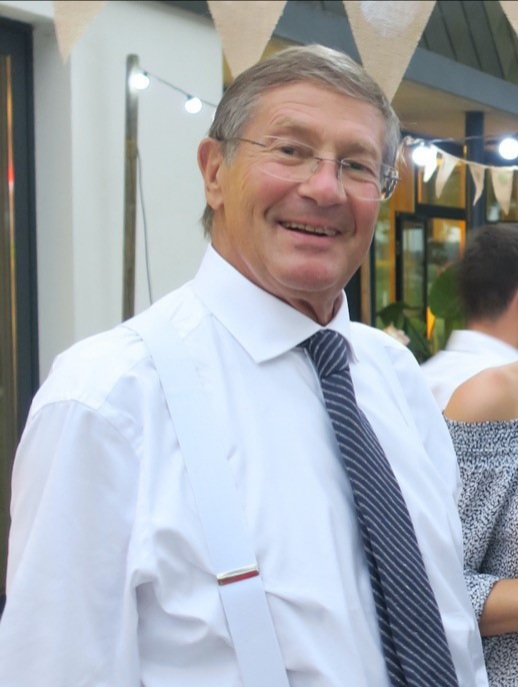
I have met many wonderful people in my decades in wine. One I have especially fond memories of just passed away last week.
Frank Wilhelm was long associated with the famous Trimbach firm of Ribeauvillé; he joined the family almost fifty years ago after attending a Strasbourg business school and working week-ends at the then three Michelin starred prestigious Auberge de l’Ill restaurant in Illhaursen, made famous by the Haeberlin chef family (and where many other famous chefs, such as Hubert Keller of San Francisco’s famed Fleur de Lys, apprenticed). That time would serve Wilhem well: it was in fact by watching him “in operation” among the tables and dealing with the customers that Hubert and Bernard Trimbach decided to ask if he might like to join the family and help sell their wines in France’s best restaurants. A true people’s person, and one who brought a certain joie de vivre along everywhere he went, Wilhelm was outstanding at his job, serving as Trimbach’s Sales Director for close to fifty years until his retirement in 2017 (succeeded at the time by Antoine Haber, past sommelier of the Buerehisel, also a three Michelin star restaurant).
Extremely competent and knowledgeable, it was basically impossible not to like him or to resist his smile, for that matter: in time, he helped develop the sales of Trimbach wines in Germany, Belgium, Luxembourg and Austria. A cultured bon vivant, one who truly enjoyed and understood the art de vivre rather than just chasing labels and names like far too many a parvenu of today’s wine world, he became friends with many wine professionals, first and foremost the world’s leading chefs. That long list of names includes Pierre Gagnaire (when his first restaurant was in Clermont-Ferrand), Pierre Wynants (Comme Chez Soi restaurant in Bruxelles), Eckhart Witzigman (of Munich’s three Michelin star Restaurant Aubergine), Joel Robuchon, and many others still.
Wilhelm was also one of the first members of the Association des Sommeliers d’Alsace (ASA) whose president at the time was Serge Dubs (longtime head sommelier at Auberge de l’Ill and at one time also president of the Association de la Sommellerie Internationale, or ASI) and its Honorary president Emile Jung (of Strasbourg’s then three Michelin star Le Crocodile restaurant). In the words of Jean Trimbach, who was only twelve years old when Wilhelm started working for the family, “… Frank’s long list of nick-names, such as Franz, Franzele, Fitzel, and many more still, testify to the numerous friends he had”. For in ultimate analysis, Frank Wilhelm was not just a splendid ambassador of the great wines of Trimbach, but of Alsace in general, and appreciation for him and his work was vast.
I first met Frank Wilhelm in 1982 or 1983, memory fails me now. I don’t even remember if it was in Alsace or Rome, where I was living at the time, but I actually think it was in Rome. He undoubtedly contributed to the great love I have for Alsace, its wines, its food, its people, and its immense natural beauty
Maybe that’s not so important, though as you can tell by this that you are reading, it is something I have never forgotten.
Far more importantly, Frank Wilhem was a really nice man. And nobody will forget that either.

 English
English




It is a delicate gesture to pay Homage to the persons who have influenced us in the wine world.
After all the wine scene is very much an actor’s game.
I hadn’t had the pleasure of meeting Mr. Wilhelm but a few things grabbed my attention reading this obituary.
First, apparently Mr. Wilhelm saw wine as “art de vivre” (my war cry!) something that I presume more than one reader of Terroir Sense may appreciate and agree with.
Then I travel down memory lane when you mentioned:
Buerheisel in Brussels, where I partake in an anthology dinner thanks to Antoine Westermann enriched with the most satisfying interaction with the somm that night for his Burgundy recommandation…
Then you continue :
“Pierre Gagnaire (when his first restaurant was in Clermont-Ferrand)”
This is where between 1993-1996 I had the pleasure of discovering the Condrieu of Vernay and was appreciative of the inventive food served at the piano nobile level dinning room of this extravagant art deco villa.
Finally, you mention Emile Jung that I met in 1992 at a special dinner prepared by Gérard Vié chef of les Trois Marches (and served at the Trianon Palace) with Inuit and the Canadian Great North ingredients flown via ‘valise diplomatique’ for the occasion…
Émile Jung was present and invited us to come to see him at Le Crocodile later on, something that happened in 1995 if I remember correctly.
The ‘art de vivre’ surrounding les ‘arts de la table’ is a small world Ian and when you start reminiscing fine moments you experienced in the past, the names that you mention triggers memories in the wine aficion at large.
Richard,
thanks for the lovely letter and your personal remembrances. I apologize for not getting back to you sooner. Yours is really a nice thoughtful gesture and I couldn’t agree more with all you say. It’s really all about the evocative power of good writing and memories that stem from it, such as those you mention in your beautifully phrased letter. I am sure that many wine and food lovers out there experience the same sort of epiphany when they come across paragraphs that relate to them in some way. And it does not all have to be on a personal level, ether: for example, it was fun for me to read your past experiences.
Thanks Ian;
It just hit me, for the record, Pierre Gagnaire first restaurant was not in not in Clermont Ferrand, but in St Étienne;
You mentioned CF in the obit and I ran with it…
As for the memories of the dinners it brought back, I should go in my
Souvenir trunk, I kept quite a few menus as mementos; the ones with the Canadian Great North products meeting French chefs is certainly highly original; the event in Versailles was reproduced in Monaco at the Musée océanographique and topped up for good measure with a cappella throat singing by the Inuit delegation…
And to make that evening surreal, I remember Prince Albert telling me hat he loved the snow…. so much so that he was training with the bobsleigh team of Jamaica (read those few words and try not to laugh Ian). I had to summon all my butler restraint training to nod and look appreciative and unsurprised with a « évidemment, mais c’est bien sûr » kind of body language.
Ciaoo, my mistake you are right but I actually didn’t mean the first restaurant he opened in Saint-Etienne in 1991, but rather his very first restaurant stint at his family’s place not in Clermont -Ferrand but at Le Clos Fleuri neither in Saint-Etienne nor in Clermont-Ferrand but in Saint-Priest-en-Jarez, where he won his first Michelin star the year he took it over, in 1976. After closing the family place he went on to his own restaurant in 1981, going on to the full three stars before unfortunately having to pack up shop and move to paris where he ahs had smashing and deserved success…. And good for you, Pince Albert is a really nice guy! Thanks as always for your memories, they are a lot of fun to read through not just for me but for everyone else too, I’m sure! Ian
PG, quite a talent and driven enough to pick himself up an fight back after St Étienne to world acclaim in Paris and beyond…